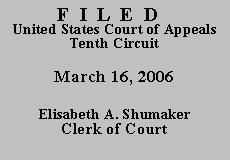 UNITED STATES COURT OF APPEALS
UNITED STATES COURT OF APPEALS
 UNITED STATES COURT OF APPEALS
UNITED STATES COURT OF APPEALS
| UNITED STATES OF AMERICA,
Plaintiff-Appellee, v. THOMAS DOSS GANN, Defendant-Appellant. |
(Nos. CIV-04-224-P and 00-CR-21)
|
APPEALABILITY
Following a jury trial, Gann was found guilty of seven counts of an eleven-count indictment relating to a conspiracy to manufacture and distribute methamphetamine. He was sentenced to three concurrent 240-month sentences, three concurrent 60-month sentences, and one consecutive 60-month sentence, for a total term of 300 months' imprisonment. His conviction was affirmed on appeal. Gann filed a § 2255 petition in the court below claiming ineffective assistance of counsel. The district court denied both the petition and Gann's subsequent application for a COA. Gann now seeks a COA from this court, asserting the same claims of ineffective assistance that he raised below.(1)
Gann first argues that his counsel failed to challenge the drug quantity determination at sentencing. He asserts that the district court determined the applicable drug amount based on quantities of waste water and other by-products of the methamphetamine production process. Section 2D1.1 of the Guidelines prohibits consideration of "materials that must be separated from the controlled substance before the controlled substance can be used," and Gann complains that his counsel did not object to the district court's consideration of these prohibited materials. Had counsel successfully challenged the court's drug quantity finding, Gann claims that his offense level would have been 26 rather than 36.
To prevail, Gann must prove that his lawyer's representation fell below an objective standard of reasonableness and that the deficient representation prejudiced Gann. Strickland v. Washington, 446 U.S. 668, 687-88 (1984). Even if we assume that the trial court did consider methamphetamine waste water and chemical by-products, and that Gann's counsel did not object, Gann has not demonstrated that he was prejudiced. As the court below found, the PSR reported that the pseudophedrine seized from Gann could potentially yield 507 grams of methamphetamine (actual). This amount alone suffices to place Gann at a base offense level of 36. Moreover, trial testimony revealed that one gallon of liquid methamphetamine was attributable to Gann, which is consistent with the 1,000 milliliters of liquid methamphetamine discussed in the PSR. In sum, Gann's base offense level of 36 was supported by facts revealed at trial and at sentencing without regard to any wastewater or chemical by-products.
Gann next argues that his counsel failed at sentencing to argue relevant conduct applicable to Count Three, which charged that Gann maintained a place for manufacturing, distributing, and using methamphetamine. Pursuant to U.S.S.G. § 2D1.8(a)(2), one who "had no participation in the underlying controlled substance offense other than allowing use of the premises," receives a four-level reduction in base offense level. Gann asserts that his counsel failed to argue at sentencing that Gann merely allowed others to use his premises for manufacturing, distributing, and using methamphetamine, and that Gann had no other participation on the offense. As this court noted on appeal, the totality of the evidence proves that the methamphetamine distribution conspiracy "was a 'family business,' involving Doug Gann, [Thomas] Doss Gann and Irene Gann, and others, at both the Ridge Drive and Chicken Creek properties." United States v. Gann, 58 Fed. Appx. 792, 798 (10th Cir. 2003) (unpublished). Gann presents no argument challenging this finding. Therefore, he has not shown that counsel was ineffective for declining to assert that Gann's only participation in the conspiracy was to permit use of his property.
In a related argument, Gann asserts that his counsel should have objected to the indictment, on the basis of duplicity, given that the indictment lists two residences under Count Three. It is entirely proper for the government to charge use of two residences under a single count concerning maintenance of a place for manufacturing, distributing, and using methamphetamine. See, e.g., Richardson v. United States, 526 U.S. 813, 817 (1999) ("a federal jury need not always decide unanimously which of several possible sets of underlying brute facts make up a particular element, say, which of several possible means the defendant used to commit an element of the crime"). Moreover, as we previously determined on appeal, Gann had "a sufficient 'nexus' with both properties" to establish his dominion and control over firearms found at both locations. Gann, 58 Fed. Appx. at 802. His counsel's failure to challenge Count Three was not objectively unreasonable.
Finally, Gann argues that his trial counsel did not effectively impeach a government witness named Steve Smith. The district court found that "even if Mr. Smith's entire testimony were stricken from the record, the result of Petitioner's trial would have been the same. Accordingly, Petitioner has failed to establish prejudice." Gann has not persuaded us that reasonable jurists could debate whether the district court should have resolved this issue differently.
We DENY Gann's application for a COA and DISMISS. We DENY Gann's request for abeyance.
ENTERED FOR THE COURT
Carlos F. Lucero
Circuit Judge
1. Gann's petition was filed after April 24, 1996, the effective date of the Antiterrorism and Effective Death Penalty Act ("AEDPA"); as a result, AEDPA's provisions apply to this case. See Rogers v. Gibson, 173 F.3d 1278, 1282 n.1 (10th Cir. 1999) (citing Lindh v. Murphy, 521 U.S. 320 (1997)). AEDPA conditions a petitioner's right to appeal a denial of habeas relief under § 2254 upon a grant of a COA. 28 U.S.C. § 2253(c)(1)(A). A COA may be issued "only if the applicant has made a substantial showing of the denial of a constitutional right." § 2253(c)(2). This requires Gann to show "that reasonable jurists could debate whether (or, for that matter, agree that) the petition should have been resolved in a different manner or that the issues presented were adequate to deserve encouragement to proceed further." Slack v. McDaniel, 529 U.S. 473, 484 (2000) (quotations omitted). Because the district court denied Gann a COA, he may not appeal the district court's decision absent a grant of COA by this court.